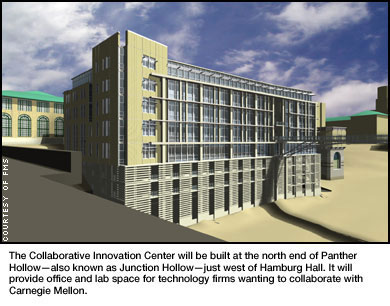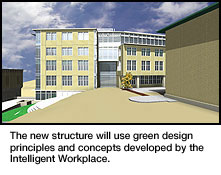|
|
||
|
|
|
 Groundbreaking Anticipated for New Collaborative Innovation Center Construction to Begin Early in 2003 Officials at Carnegie Mellon, the Carnegie Museums of Pittsburgh, the Regional Industrial Development Corporation of Southwestern Pennsylvania (RIDC) and the J.J. Gumberg Co. are anticipating the official groundbreaking for the new $27.9 million Collaborative Innovation Center. Construction at the north end of Panther Hollow—also known as Junction Hollow—just west of Hamburg Hall and adjacent to the Facilities Management Services (FMS) building, is expected to begin early in 2003.
The purpose of the new four-story, 136,000-square-foot structure is to provide office and lab space for technology companies wishing to collaborate with Carnegie Mellon to create innovative new concepts and products for the marketplace. Ultimately, the hope is that these companies will establish roots in Pittsburgh, thereby creating jobs for university graduates and bolstering economic development in southwestern Pennsylvania.
Specific plans for the Collaborative Innovation Center on the Carnegie Mellon campus were first introduced about a year ago by the Panther Hollow Development Corporation (PHDC), a partnership between Carnegie Mellon and the Carnegie Museums of Pittsburgh. The PHDC was established to promote a two-phase development of the Panther Hollow corridor for technology companies and startups that wish to expand their research. A future phase of the development project would propose a second structure near the Carnegie Museums of Pittsburgh. The Collaborative Innovation Center will be developed by the J.J. Gumberg Co. with the RIDC serving as the initial owner. The RIDC will lease the land for the building from the university. Ken Kimbrough, assistant vice president for Facilities Management Services, noted that "the RIDC is a not-for-profit developer, so it can use public funds to finance the facility. RIDC will fund the building with an $8-million grant from the Commonwealth of Pennsylvania, a $3.4-million Tax Increment Financing loan and a $27-million first mortgage." "The RIDC is pleased to be able to cooperate and work with Carnegie Mellon on the development of this project," said Frank Brooks Robinson, RIDC president. "Carnegie Mellon is a true engine for the economic development of this region and a good part of that is due to the excellent relationships that have been developed between the various departments at Carnegie Mellon, the U.S. government and industry. "The university's contractual relationships in software engineering, biomedical research and robotics hit the hot button for what will drive the economy in the future." Robinson said the building will serve as an "open doorway to the university" that will allow "private industry to conduct research in a stimulating academic environment that will help bring ideas to the marketplace."
Smith, who estimated that the new building will house about 300 employees, said the center will be a "huge impetus for the growth of the knowledge economy in the region, but it's only the beginning." He said additional space is needed for information technology and security technology companies, as well as for pharmaceutical and biomedical and life sciences companies that want to be near Pittsburgh's universities. The Collaborative Innovation Center will sit atop a four-story, 200-vehicle parking structure that will be built into the hillside beside Hamburg Hall. Vehicles will approach the parking structure from Oakland's Neville and Boundary streets and from the university's Roberts Road. Pedestrian access to the building will be available from the Hamburg Hall parking lot. About a dozen visitor parking spaces will be created in the Hamburg Hall metered parking area directly off Forbes Avenue. Designed by the Pittsburgh firm Davis Gannon Gardner Pope Architecture, LLC, the building will employ green design principles and seek certification from the Leadership in Energy and Environmental Design (LEED) Green Building Rating System. LEED, developed by the U.S. Green Building Council, evaluates projects in several categories, such as the building materials used, energy and water efficiency and indoor environmental quality. Kimbrough said the Collaborative Innovation Center will use concepts developed by the Intelligent Workplace, like its raised floor system. As part of the system, electrical power, telecommunications and air distribution mechanisms will be placed under 24" x 24" floor panels, allowing for office flexibility and easy reconfiguration to accommodate team projects. J.J. Gumberg Co., the building developer and operator, will represent RIDC on site during construction. P.J. Dick Incorporated will be the construction management firm. Once construction begins, Kimbrough said the project should be completed in about 18 months. �
�
Top�
�
�
Bruce Gerson
|
|
This Issue's Headlines || Carnegie Mellon News Home || Carnegie Mellon Home |
||

 Don Smith, vice president for economic development at Carnegie Mellon and the University of Pittsburgh, said all the technology companies that are interested in coming to Pittsburgh want to be within walking distance of the universities.
"They want to have the type of interaction you can only have when you're in close proximity," Smith said. "They want to be close to the students, researchers and technologies being created."
Don Smith, vice president for economic development at Carnegie Mellon and the University of Pittsburgh, said all the technology companies that are interested in coming to Pittsburgh want to be within walking distance of the universities.
"They want to have the type of interaction you can only have when you're in close proximity," Smith said. "They want to be close to the students, researchers and technologies being created."